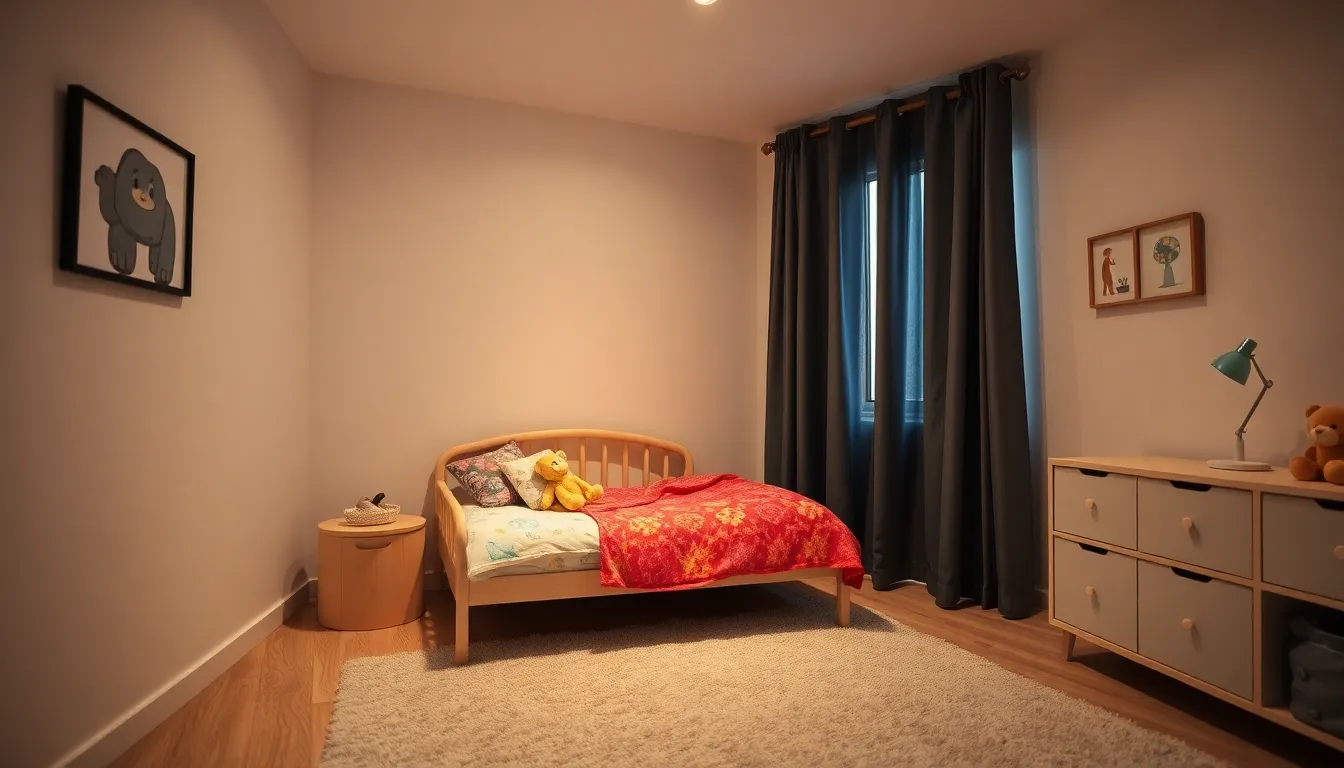Getting toddlers to sleep can feel like trying to negotiate a peace treaty with a tiny dictator. One moment they’re wide-eyed and full of energy, and the next, they’re bouncing off the walls like they’ve consumed a gallon of sugar. Parents everywhere know the struggle, and it’s no laughing matter—except when it is.
Table of Contents
ToggleUnderstanding Toddler Sleep Patterns
Understanding toddler sleep patterns helps parents navigate bedtime challenges. Sleep needs vary greatly during this developmental stage.
Typical Sleep Needs for Toddlers
Toddlers typically need 11 to 14 hours of sleep each day, including nighttime sleep and naps. Most children require one or two naps depending on their age. Sleep often consists of deep sleep and lighter sleep cycles. Sleep schedules might shift as toddlers grow, moving from two naps to one by age 15 months. Maintaining a consistent bedtime encourages a smoother transition into sleep. Recognizing signs of tiredness, such as rubbing eyes or fussiness, improves sleep quality.
Common Sleep Challenges Faced by Parents
Many parents encounter significant sleep challenges with toddlers. Frequent night wakings disrupt everyone’s rest, leading to fatigue. Transitioning away from naps can also create difficulties. Some toddlers resist settling down, often out of energy or overstimulation. Bedtime routines might become extended and unpredictable. Sibling distractions and environmental factors like noise also contribute to sleep disruptions. Identifying and addressing these issues can make bedtime more manageable.
Creating a Sleep-Friendly Environment

Creating a sleep-friendly environment can significantly enhance a toddler’s ability to fall asleep. Proper conditions promote relaxation and comfort.
Ideal Sleep Conditions
Quiet surroundings contribute to sleep quality. Darkness signals to the brain that it’s time to wind down. Maintaining a comfortable room temperature between 68°F and 72°F fosters a restful atmosphere. A cozy bed with familiar blankets or stuffed animals can offer reassurance. Consistency in the environment also eases the toddler into sleep, so using the same room for naps and nighttime rest is beneficial.
Tips for Reducing Noise and Light
Minimizing noise is crucial. Soft background sounds, like white noise or gentle lullabies, can mask disruptive noises. Using blackout curtains prevents daylight from entering the room during sleep. Engaging in a quiet, calming bedtime routine prepares toddlers for sleep by signaling the transition. Avoiding loud activities nearby helps establish a peaceful environment conducive to falling asleep.
Establishing a Consistent Bedtime Routine
A consistent bedtime routine plays a crucial role in promoting better sleep for toddlers. Following the same steps each night helps signal to toddlers that it’s time to wind down. This predictability reduces anxiety and sets the stage for a smoother transition to sleep.
Importance of Routine
Routine establishes a sense of security for toddlers, allowing them to understand what to expect. Regular sleep patterns contribute to better overall mood and behavior. Research indicates that toddlers with consistent bedtimes experience fewer night wakings and improved sleep quality. Creating a calming environment paired with a stable routine encourages relaxation, making it easier for toddlers to settle down. Parents must recognize that these routines can evolve as children grow, adapting to their changing sleep needs while maintaining a sense of structure.
Activities to Include in the Routine
Incorporating calming activities into the bedtime routine enhances relaxation. Some helpful activities include reading a favorite book, singing a lullaby, or practicing gentle stretches. Engaging in quiet play, such as coloring or puzzle-solving, also helps toddlers transition from active play to sleep mode. Bath time can serve as an excellent pre-bedtime activity, promoting comfort and hygiene. Consistency in these activities reinforces their association with sleep, making the transition smoother over time. Each step should last around 5 to 15 minutes, ensuring that toddlers remain engaged without becoming over-stimulated.
Effective Techniques for Soothing Toddlers
Soothing toddlers at bedtime can involve simple yet effective techniques to foster relaxation.
Methods for Calming Before Bedtime
Engaging in calming activities helps signal that it’s time to wind down. Establishing a short routine, around 15 minutes, prepares toddlers for sleep. Reading a favorite story encourages connection while calming the mind. Singing soft lullabies creates a soothing atmosphere, making bedtime enjoyable. Gentle stretches reduce physical tension, promoting relaxation before sleep. Dim lights signal to the child that night is approaching, enhancing their grasp of bedtime. By creating predictable patterns, toddlers feel more secure, easing anxiety around sleep.
The Role of Comfort Objects
Comfort objects provide security during bedtime routines and throughout the night. A favorite stuffed animal or blanket can help ease fears and enhance feelings of safety. Depending on the child, familiar scents, such as a parent’s worn shirt, may also offer comfort. This familiarity fosters emotional stability, making transitions smoother. When allowed to choose their comfort object, toddlers develop a sense of autonomy. Having these objects nearby can decrease separation anxiety, contributing to a more peaceful sleep environment. The presence of comfort items reinforces positive sleep associations.
Addressing Nighttime Fears and Anxieties
Nighttime fears and anxieties are common challenges for toddlers. Identifying and addressing these fears can significantly enhance the sleep experience.
Recognizing Common Fears
Monsters, darkness, and separation anxiety frequently trigger sleep disturbances. Many toddlers fear imaginary creatures lurking in the shadows, which can lead to reluctance at bedtime. Some children feel anxious about being alone in their rooms after a day filled with activity. Sensitivity to these common fears allows parents to provide reassurance. Observing behavioral signs, such as clinginess or crying, can also indicate underlying anxieties. Understanding these fears helps create a supportive environment that enables toddlers to settle down peacefully.
Strategies for Comforting Your Toddler
Implementing effective strategies can help alleviate nighttime anxieties. Offering comfort objects, like a favorite toy or blanket, provides tangible security. Establishing a calming pre-sleep routine, such as reading a story or singing lullabies, fosters relaxation. Dimmed lights can signal to toddlers that bedtime is approaching, creating a soothing atmosphere. Encouraging discussions about their fears can further help toddlers feel understood. Using gentle language and providing validation helps them navigate their feelings. Engaging in consistent routines cultivates a sense of safety, allowing toddlers to feel secure enough to drift off to sleep.
Getting toddlers to sleep can feel like a daunting task but with the right strategies in place, it doesn’t have to be. By understanding their unique sleep patterns and establishing a consistent bedtime routine, parents can create a calming environment that promotes better sleep. Incorporating soothing activities and addressing nighttime fears can significantly ease the transition to sleep.
It’s essential to remember that each child is different, and what works for one may not work for another. Patience and flexibility are key as parents navigate this journey. With time and practice, bedtime can transform from a battle into a peaceful ritual that benefits both toddlers and parents alike.



